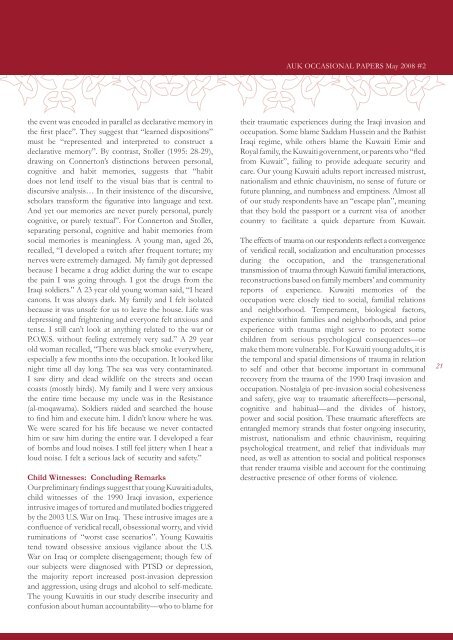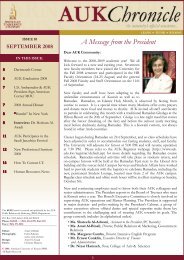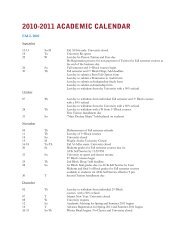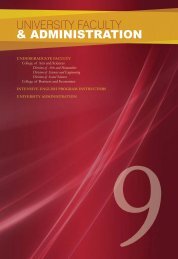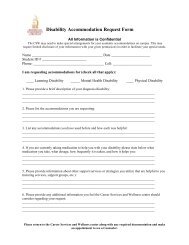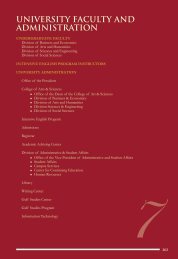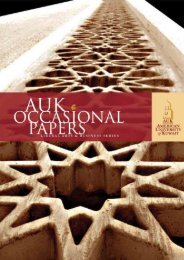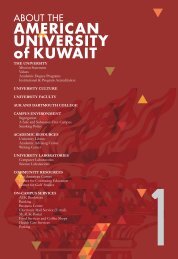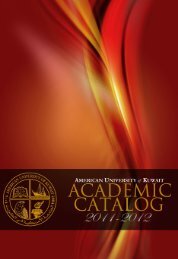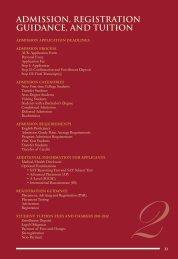the event was encoded in parallel as declarative memory inthe first place”. They suggest that “learned dispositions”must be “represented and interpreted to construct adeclarative memory”. By contrast, Stoller (1995: 28-29),drawing on Connerton’s distinctions between personal,cognitive and habit memories, suggests that “habitdoes not lend itself to the visual bias that is central todiscursive analysis… In their insistence of the discursive,scholars transform the figurative into language and text.And yet our memories are never purely personal, purelycognitive, or purely textual”. For Connerton and Stoller,separating personal, cognitive and habit memories fromsocial memories is meaningless. A young man, aged 26,recalled, “I developed a twitch after frequent torture; mynerves were extremely damaged. My family got depressedbecause I became a drug addict during the war to escapethe pain I was going through. I got the drugs from theIraqi soldiers.” A 23 year old young woman said, “I heardcanons. It was always dark. My family and I felt isolatedbecause it was unsafe for us to leave the house. Life wasdepressing and frightening and everyone felt anxious andtense. I still can’t look at anything related to the war orP.O.W.S. without feeling extremely very sad.” A 29 yearold woman recalled, “There was black smoke everywhere,especially a few months into the occupation. It looked likenight time all day long. The sea was very contaminated.I saw dirty and dead wildlife on the streets and oceancoasts (mostly birds). My family and I were very anxiousthe entire time because my uncle was in the Resistance(al-moqawama). Soldiers raided and searched the houseto find him and execute him. I didn’t know where he was.We were scared for his life because we never contactedhim or saw him during the entire war. I developed a fearof bombs and loud noises. I still feel jittery when I hear aloud noise. I felt a serious lack of security and safety.”Child Witnesses: Concluding RemarksOur preliminary findings suggest that young Kuwaiti adults,child witnesses of the 1990 Iraqi invasion, experienceintrusive images of tortured and mutilated bodies triggeredby the 2003 U.S. War on Iraq. These intrusive images are aconfluence of veridical recall, obsessional worry, and vividruminations of “worst case scenarios”. Young Kuwaitistend toward obsessive anxious vigilance about the U.S.War on Iraq or complete disengagement; though few ofour subjects were diagnosed with PTSD or depression,the majority report increased post-invasion depressionand aggression, using drugs and alcohol to self-medicate.The young Kuwaitis in our study describe insecurity andconfusion about human accountability—who to blame fortheir traumatic experiences during the Iraqi invasion andoccupation. Some blame Saddam Hussein and the BathistIraqi regime, while others blame the Kuwaiti Emir andRoyal family, the Kuwaiti government, or parents who “fledfrom Kuwait”, failing to provide adequate security andcare. Our young Kuwaiti adults report increased mistrust,nationalism and ethnic chauvinism, no sense of future orfuture planning, and numbness and emptiness. Almost allof our study respondents have an “escape plan”, meaningthat they hold the passport or a current visa of anothercountry to facilitate a quick departure from Kuwait.The effects of trauma on our respondents reflect a convergenceof veridical recall, socialization and enculturation processesduring the occupation, and the transgenerationaltransmission of trauma through Kuwaiti familial interactions,reconstructions based on family members’ and communityreports of experience. Kuwaiti memories of theoccupation were closely tied to social, familial relationsand neighborhood. Temperament, biological factors,experience within families and neighborhoods, and priorexperience with trauma might serve to protect somechildren from serious psychological consequences—ormake them more vulnerable. For Kuwaiti young adults, it isthe temporal and spatial dimensions of trauma in relationto self and other that become important in communalrecovery from the trauma of the 1990 Iraqi invasion andoccupation. Nostalgia of pre-invasion social cohesivenessand safety, give way to traumatic aftereffects—personal,cognitive and habitual—and the divides of history,power and social position. These traumatic aftereffects areentangled memory strands that foster ongoing insecurity,mistrust, nationalism and ethnic chauvinism, requiringpsychological treatment, and relief that individuals mayneed, as well as attention to social and political responsesthat render trauma visible and account for the continuingdestructive presence of other forms of violence.21
22ReferencesAbdel-Khalek, A.M., (1996). Factorial Structure of theArabic Children’s Depression Inventory Among KuwaitiSubjects. Psychological Reports, 78, 963-967.Abdel-Khalek, A.M., (1997). A Survey of Fears Associatedwith Iraqi Aggression Among Kuwaiti Children andAdolescents: A Factorial Study 5.7 years After the GulfWar. Psychological Reports, 81, 247-255.Abdel-Khalek, A.M., (1998). Criterion-Related Validity ofthe Arabic Children’s Depression Inventory. PsychologicalReports, 82, 930.Abdel-Khalek, A.M. & Soliman, H.H. (1999). A Cross-Cultural Evaluation of Depression in Children in Egypt,Kuwait, and the United States. Psychological Reports, 85,973-980.Abdel-Khalek, A.M.,(2003). The Multidimentional Child andAdolescent Depression Scale: Psychometric Properties.Psychological Reports, 93, 544-560.Abdel-Khalek, A.M. (2004). The Arabic Scale of DeathAnxiety (ASDA): Its Development, Validation, and Resultsin Three Arab Countries. Death Studies, 28, 435-457.Abdel-Khalek, A., & Lester, D. (2002).Manic-Depressiveness, Obsessive-Compulsive Tendencies,and Suicidality in Kuwaiti College Students. PsychologicalReports, 90, 1007-1008.Abdel-Khalek, A., & Lester, D. (2003). The Kuwait UniversityAnxiety Scale: A Cross-Cultural Evaluation in Kuwait andUnited States. Psychological Reports, 93, 1109-1114.Abdullatif, H.I., (1995). Prevalence of Depression amongMiddle-School Kuwaiti Students Following the IraqiInvasion. Psychological Reports, 77, 643-649.Ahmad, A., Sofi, M.A., Sundelin-Wahlsten V, von KnorringA.L. (2000). Posttraumatic Stress Disorder in Childrenafter the Military Operation “Anfal” in Iraqi Kurdistan.European Child& Adolescent Psychiatry, 9, 235-243.Al-Naser, F., al-Khulaifi, I.M., & Martino, C. (2000).Assessment of Posttraumatic Stress Disorder Four andOne-Half Years after the Iraqi Invasion. InternationalJournal of Emergency Mental Health, 2 (3) : 153-56.Capps, L. and Ochs, E. (1995). Constructing Panic : TheDiscourse of Agoraphobia. Cambridge: Harvard UniversityPress.Connerton, P. (1989). How Societies Remember. Cambridge:Cambridge University Press.Frankel, F. H. (1994). The concept of flashbacks inhistorical perspective. International Journal of Clinical andExperimental Hypnosis, 42( 4), 321-336.Hadi, F.A., & Liabre, M. M. 1997). Social Support andPsychological Distress in Kuwaiti Boys and Girls Exposedto the Gulf Crisis. Journal of Clinical Child Psychology, 3(2),247-255.Hadi, F.A., & Liabre, M. M. 1998). The Gulf CrisisExperience of Kuwaiti Children: Psychological andCognitive Factors. Journal of Traumatic Stress, 11. 45-56.Kirmayer, L., Lemelson, R., & Barad, M. (2007) UnderstandingTrauma: Integrating Biological, Clinical, and Cultural Perspectives.New York: Cambridge University Press.Lester, D. & Abdel-Khalek, A. (1998). Depression in CollegeStudents in the United States and Kuwait. PsychologicalReports, 83, 410.Lester, D. & Abdel-Khalek, A. (2003). Obsession-Compulsionand its Relation to Age and Sex in Kuwaiti and AmericanStudents. Psychological Reports, 93, 803-804.Llabre, M. and Hadi, F. A. 1997). Social Support andPsychological Distress in Kuwaiti Boys and Girls Exposedto the Gulf Crisis. Journal of Clinical Child Psychology, 26(3): 247-255.Manu, P. (2004). The Psychopathology of Functional SomaticSyndromes. New York: The Haworth Medical Press.Nader, K.O., Pynoos, R.S., Fairbanks, L.A., al-Ajeel, M.,& al-Asfour A. (1993). A Preliminary Study of PTSDandGrief among the Children of Kuwait Following the GulfCrisis. British Journal of Clinical Psychology, 32 (4): 407-416.Nordstrom, C. (2004). Shadows of War: Violence, Power, andInternational Profiteering in the Twenty-First Century. Berkeley:University of California Press.
- Page 2 and 3: About AUK Occasional Papers:The AUK
- Page 4 and 5: higher education is distinguished b
- Page 6 and 7: The Impact of a Glass Ceilingon Wom
- Page 8 and 9: more women a chance to flourish in
- Page 10 and 11: consider other factors such as the
- Page 12 and 13: academically unprepared…you must
- Page 14 and 15: EmotionalSignificant variations in
- Page 16 and 17: Advising and OrientationOther impor
- Page 18 and 19: etention. However, in addition, the
- Page 20 and 21: Hadi and Llabre (1998) assessed int
- Page 24 and 25: Public Health Impacts of Iraq’s 1
- Page 26 and 27: college work and have inadequate pr
- Page 28 and 29: memorization and repetition. This a
- Page 30 and 31: other in the pursuit of higher grad
- Page 32 and 33: for quality assurance, an organizat
- Page 34 and 35: RethinkingEntrepreneurship:Integrat
- Page 36 and 37: This type of training leads to enha
- Page 38 and 39: In short, Mount Allison students ha
- Page 40 and 41: Joplin, L. (1995). On defining expe
- Page 42 and 43: Figure 1. ExperientialEntrepreneurs
- Page 44 and 45: Kuwait - satellite television, cult
- Page 46 and 47: ReferencesAbt, V. & Seesholtz, M. (
- Page 48 and 49: interest in continuing to manipulat
- Page 50 and 51: Though corruption poses fundamental
- Page 52 and 53: A Cross-Cultural Modelof Innovation
- Page 54 and 55: were conceived as associations of c
- Page 56: others. In this case, confident pos
- Page 59 and 60: 58REFERENCESAmason, A. (1996) ‘Di
- Page 61 and 62: Shelton, C. and Darling, J. (2004)
- Page 63 and 64: 62• recycle natural resources use
- Page 65 and 66: 64Table Kuwait Fact Profile on Tran
- Page 67 and 68: Table Transportation and Associated
- Page 69 and 70: 68• Third, each mode of transport
- Page 71 and 72: 70• Prepare a Bank Group transpor
- Page 73 and 74:
7219. Stratford,A. (1974). Airports
- Page 75 and 76:
74may be developed in a safe and or
- Page 77 and 78:
28. Tables - 1 Environmental Manage
- Page 79 and 80:
6) EnvironmentalAwarenessNo baselin
- Page 81 and 82:
80Iran, the US, and HighlyEnriched
- Page 83 and 84:
82since the 1951 nationalization of
- Page 85 and 86:
8450% of the population is astonish
- Page 87 and 88:
86The US also approved the Shah’s
- Page 89 and 90:
88George W. Bush’s State of the U
- Page 91 and 92:
90when Iran could not keep up with
- Page 93 and 94:
92rich states, the decrease of natu
- Page 95 and 96:
94indigenous training. Specifically
- Page 97 and 98:
96It is important to note that Russ
- Page 99 and 100:
Table 1: Nuclear Powered States and
- Page 101 and 102:
100Foucault, Michel. “What are th
- Page 103 and 104:
102Ramazani, Rouhollah K. “Iran
- Page 105 and 106:
104My SCORE, OurMATCH: CommunityPar
- Page 107 and 108:
106with a mate while he does mechan
- Page 109 and 110:
108dimensions of life including for
- Page 111 and 112:
correlated to the commitment and on
- Page 113 and 114:
REFERENCESBryce, J, Frigo, T, McKen
- Page 115 and 116:
GDP $21,300, GDP growth rate 6.8%,
- Page 117 and 118:
• Less than half of the people su
- Page 119 and 120:
118TABLE 4: # 1 Gulf Country in Eco
- Page 121 and 122:
120• More men than women indicate
- Page 123 and 124:
TABLE 8: Why? X GenderGENDERMALE FE
- Page 125 and 126:
TABLE 11: Success in improving Livi
- Page 127 and 128:
TABLE 14: Success in preserving Cul
- Page 129 and 130:
• Gender wise, more men felt that
- Page 131 and 132:
TABLE 18: How foreign workers are t
- Page 133 and 134:
• In terms of the preference of e
- Page 135 and 136:
TABLE 24: Should Oil be the Basis f
- Page 137 and 138:
F i gur e 18: S hould K uwa it J oi
- Page 139 and 140:
13811. What do you think about the
- Page 141 and 142:
140Conditions of Kuwaiti Dependence
- Page 143 and 144:
1422) if the alien has no means of
- Page 145 and 146:
144offered Mubarak recognition as a
- Page 147 and 148:
146labor regulations and enforcemen
- Page 149 and 150:
148intensifying suspicion and hosti
- Page 151 and 152:
150Commission on Freedom of the Pre
- Page 153 and 154:
Even the viceroy of India, Lord Cur
- Page 155:
Christine PiconeAustralian College


